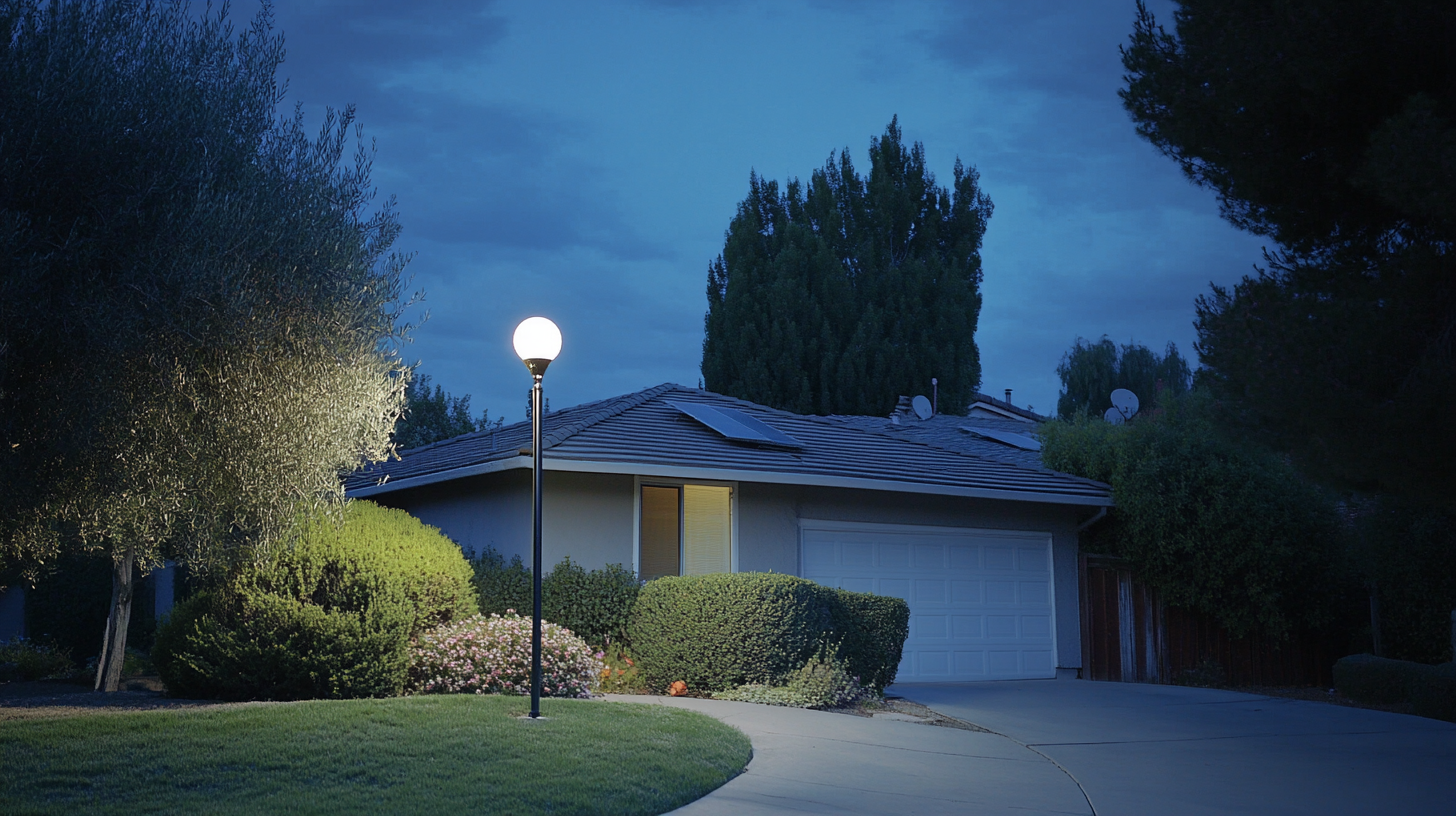Exploring the Technical Specifications of Solar Powered Outdoor Lights and How to Optimize Their Efficiency
In redefining the way we illuminate outdoor spaces, the increasing use of solar-powered outdoor lights is becoming a common approach. Solar energy was estimated to generate up to 13% of the world's electricity demand by 2030, as recorded in a report by the International Renewable Energy Agency (IRENA). It thus emphasizes the significance of expanding the renewable energy sources utilization. Besides, solar-powered outdoor lights do not only promote energy savings but help, too, in reducing carbon footprints. They do not depend on the grid for power, thus suitable for rural and off-grid areas. The possible application of solar energy is what made various lighting solutions famous. The growth of the market for solar outdoor lighting is expected to hit 2.5 billion U. S. dollars by 2025.
Solar-powered outdoor lights must be optimally efficient to make sure that they perform effectively and last for long. Generally, solar panel quality, battery capacity, and light output are some of the major factors that directly affect how well a solar powered outdoor light system converts sunlight into usable energy for the entire system. Industry studies have shown that some important advancements in technology like the infusion of LED lighting and smart control systems can add as much as 30% efficiency in conversion. Knowledge of these tech specifications allows the buyers to intelligently choose products that not only contribute positively to environmental goals but also assure function during all seasons. When looking at the massive details assigned to solar operated outdoor lights, one has to arrive at the conclusion that optimal efficiency is defined as a sustainable pathway to making outdoor light brighter and greener.

Understanding Solar Panel Technology in Outdoor Lighting
It really helps to have an understanding of solar panel technology as far as making these solar powered outdoor lights work efficiently and last longer. The photovoltaic (PV) cells in these systems provide the electric power based on sunlight exposure. According to several reports that have come out of the industry, efficiency in solar cells has significantly improved throughout its lifetime, from 15-22% efficiency for conventional silicon crystalline panels to more than 28% for some highly claimed efficiency by coming technologies, particularly bifacial solar panel. Placement and orientation when installing a solar panel have been regarded as one of the most important performance factors. The proximity to shade and angle of sunlight according to geographic location can very adversely affect this amount. The National Renewable Energy Laboratory (NREL) further confirmed that the maximum tilt angle optimization could lead to capturing nearly 20% more energy. Hence, manufacturers invest in either adjustable mounts or fixed installations that maximize sunlight capture throughout the day. Another important aspect is the battery storage technology in solar outdoor lighting. Some of the misconceptions about the cost of batteries compared with conventional lead-acid batteries are further widened by lithium-ion batteries because they yield more energy density, longer life and in many cases low-cost alternatives for some applications. As indicated by the study of the International Renewable Energy Agency (IRENA), modern lithium-ion batteries will last more than 10 years in lifecycle, ensuring that the lights are working in times when sunlight incidence is low. By learning these technicalities, consumers will be placed to learn and meaningfully choose ways that boost the performance of solar outdoor lighting.

Key Features of Solar Powered Outdoor Lights
Outdoor solar lights have become a necessity for optimal lighting during the longer winter nights when daylight is far lesser than during summertime. The most important criterion for choosing solar lights is stability and efficiency, especially for places without public lighting. The performance of such lights is attributed to their integrated solar panel and durable construction with smart technology features.
With motion detection and smart time control, solar outdoor lights have shown a significant agility in advancement. These features keep energy-saving lights to have longer life use and increase the functional properties of such lighting. Currently, around 47% is the market share for solar outdoor lighting, which is increasing as these lights go environment-friendly and cost-effective. Such all-in-one solar street lights and other variants for using versatile landscape lights to fit parks, gardens, and urban settings, thereby creating new innovations in the design being made by the manufacturers.
Installation, too, is one of the many important factors besides going for aesthetics. It is also used for aesthetic purposes, as modern solar lights can go into multiple designs. It serves the purpose of increasing safety and maybe putting the decorative beauty of outdoor spaces to display with proper lighting at remote dark areas. As winter comes, so does the demand for reliable and efficient solar outdoor lighting, which will bring more innovations into this already dynamic industry.

Factors Affecting Solar Light Efficiency
Solar-powered outdoor lights are gaining ground rapidly for their renewable energy sources and environmental conservation. But solar lights could be a very inefficient energy-supplying source if subjected to various performance-affecting factors. Among such factors, the quality of solar cells used on lights is basic. New advances in solar technology, such as perovskite-organic tandem solar cells, have increased energy conversion efficiency. New findings coming in from research labs of the world indicate how these new materials have efficiencies more than those offered by silicon cells of the past and are therefore suited for outdoor lighting.
High temperatures are another major issue affecting the sunlight performance. For example, performance for solar lights dipped during a recent heatwave in Brazil due to excessive temperatures that saw solar panels reach as high as 60 degrees Celsius. Such a high temperature of operation is going to stress the equipment being used, thereby giving an adverse effect on efficiency. It is, therefore, essential that manufacturers use thermal management techniques to boost performance under various environmental settings.
Distribution of solar exposure, climate, and geographical location are engineering considerations that have a role in maximizing solar light efficiency. In regions where there is ample sunshine all year round, energy capture will be at its maximum; on the other hand, the efficiency will be reduced by shading from surrounding buildings. Information on variable parameters should be looked at by consumers and manufacturers likewise, who seek to improve the performance and reliability of solar-powered outdoor lighting. By utilizing this latest technology to overcome environmental hindrances, the solar energy system will be guaranteed to light up our outdoors.

Best Practices for Maintaining Solar Powered Outdoor Lights
Solar-powered outdoor fixtures need maintenance to last and perform optimally. One of the simplest yet most effective practices is regular cleaning. Accumulation of dust, dirt, and grime on the solar panels greatly reduces their capacity to absorb sunlight. Thus, they should be wiped gently using a soft cloth along with mild soap solution every few weeks to keep them working well; besides improving their collection of energy, this also prolongs the time they are operational.
Besides cleaning, positioning is critical in maximizing the effectiveness of solar lights. Position them in areas that have a direct exposure to sunlight throughout the day. Try to avoid shaded locations from trees or buildings, especially at peak sunlight times. If possible, also try to change the angle of the solar panels to have them get the most direct sunlight possible.
Checking the batteries is another way of maintaining them. Most solar lights have rechargeable batteries that become less effective as time passes by. Periodically checking the batteries for corrosion and replacing them as needed will mean being able to have lights come on in all seasons. Store lights in a cool, dry environment when not in use or during low-light times to prevent lighting equipment from exposed batteries and waste. Animals, dirt, and other unnatural elements might be beneficial, but these best practices are meant to ensure that solar outdoor lighting remains efficient and splendidly complementing your outdoor spaces.
Innovative Developments in Solar Lighting Technology
The innovative technological advancement of solar lighting brings a transformation in outdoor lighting by providing sustainable solutions with enhanced performance. Recently reports projected that the global solar lighting market will reach about $21 billion by 2026 and it will grow with a compound annual growth rate (CAGR) of 24.3% from 2021 to 2026. Such increase is caused by the growing awareness of renewable energy sources and preference for energy-efficient solutions.
Innovation during the last year in photovoltaic (PV) cells has dramatically improved the power conversion efficiency of solar lighting devices, while cutting-edge models now use, for example, monocrystalline silicon that can exceed efficiencies of about 22%. Furthermore, integrated lithium-ion provide storage of energy with longer illuminating times, even under overcast conditions. Altogether, these technologies optimize the performance of solar lights, allowing greater brightness and life cycles.
So much for hardware development, the smart technology is now turning into a major part of solar light systems. The features, such as motion sensors and timers, increase the utility of systems while reducing power wastage. According to the International Energy Agency, smart outdoor lighting will reduce energy consumption by more than 80%. This promotes energy efficiency along with improvements in safety and comfort in urban settings.
There is a lot of potential for solar-powered outdoor lighting to improve public areas and private properties as we continue to explore these technology enhancements toward that future when every place is green and sustainable.
